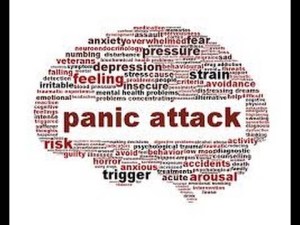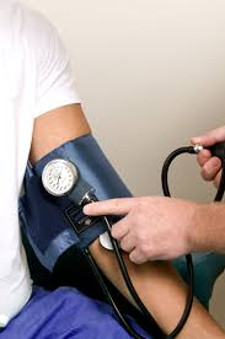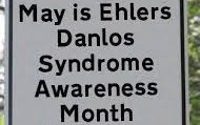Anxiety and EDS

I’m writing this post while listening to the replay of The Anxiety Summit produced by Food and Mood Gal Trudy Scott this week (June 16, 2016).
And I am not surprised to find myself falling down yet another rabbit-hole, with yet more rabbit-holes attached! (Are you?)
And unfortunately, I must say I’m finding anxiety, whether generalized or high and or episodic (panic attacks) to all be quite commonly comorbid with Ehlers-Danlos Syndrome curiously enough. (Funny, it’s awfully comorbid with autism spectrum disorders too – which are also highly comorbid with EDS. Hmm. Sensing a theme I trust?)
And just like with all of our many comorbidities and issues, anxiety can have more than one driver, and thus there are of course multiple solutions. And, no surprise, we can have (a la Hickam’s Dictum) more than one driver in the same person! And especially in Ehlers-Danlos patients. (I like to say we put the “syn” in Syndrome, smile.)
Thing is, I thought I knew much of what was driving anxiety in us before I listened to the summit. Now I feel like I know much more but still have more to learn about what drives it since listening. And there are multiple potential drivers, of course – because, EDS, smile. (Complexity is a given with us.) I will undoubtedly miss a few even in this post. And like all my posts, it’s merely a 60,000 foot (high level) overview. I could easily write a whole book on this topic alone!
But, and this is the exciting part, there is a lot we can do to help overcome our anxiety!
How so?
Well, as I’ve written before, there are often both biomechanical (X) and bio-chemical (Y) drivers of many of our issues when suffering from a connective tissue disorder. Especially if you have signs of comorbid Mast Cell Activation Disease of any kind. Think “extra” allergies and sensitivities allergists can’t easily test for, including to chemicals and vibration among myriad other things including pain and unfortunately stress.
Sure enough, as I wrote in my Depression and EDS post where I diverged and addressed anxiety a bit also as it’s so rampant and comorbid with depression in us, we show signs of both types of drivers (X and Y).
On the biomechanical (X) side, hypermobility has been associated with larger amygdalae (2012), which is the seat of emotions and directs our most primal “fight or flight” responses – often long before we can even put our fears into words. (The amygdala is one of the oldest parts of the brain from an evolutionary standpoint, that is, our most “animal” part, aka our “reptile brain”.)
No surprise, this can lead to a higher general baseline of anxiety in those enjoying this condition. Since it’s a constant (unchanging) usually, it’s not likely to vary much from day to day, and will keep our fear response ratcheted up a bit at all times until and unless we recruit our frontal lobes to quell these signals. And yes, you can do so, I have with DBT.
[Edit: adding this in 2018] This smart personal trainer has noticed a high baseline anxiety level in her hypermobile clients also. And is finding that helping them to integrate their bodies and gain better control and increased proprioception to greatly help them.
Sure enough, another study found a four times greater probability of having anxiety in those with hypermobility from BJHS or HEDS (EDS III) than in controls. (2014) I’m sure we’ll continue to see more studies observing this comorbidity as it really is quite common. The Scientific American even noticed this in 2015 in this article about people who are double-jointed being more prone to anxiety. They included side-effects from blood pooling from flaccid veins as well, which I touch on in this post also.
I will say from personal experience that I have personally lived life “like a squirrel”, reacting extremely quickly (and often anxiously) to any and all stressors, whether warranted or not. I even spent a few years fearing I might die as I was falling asleep in my late 20’s – though I now think there were more bio-chemical (Y) drivers to that. (Hold that thought.)
Toss in some rather scary childhood experiences in my dysfunctional home (house fires, parents fighting, more) and it’s sort of a wonder I ever made it to and through school and work. (Thanking my well-recruited frontal lobe now ahh, among other things I’ll share in a bit.) Many other EDS patients report rocky childhoods also, though thankfully not all.
I can’t help wondering if this doesn’t lend to our proclivity to highly comorbid PTSD as well, whether from single events, or the complex flavor (“CPTSD“) I enjoyed from my rocky home life as a child. Again, I marvel that I ever got out of bed, much less out the door through it all now, but I did. And I’m sure glad! I know some who can’t/don’t always. Seriously.
The first study I mentioned from 2012 further noted that:
“Additionally, individuals with hypermobility often exhibit autonomic abnormalities, typically postural tachycardia syndrome, where there is enhanced cardiovascular reactivity and a phenomenological overlap with anxiety disorders.3 “

Uhm ya think? I can’t imagine why sudden blood pressure drops and hypoperfusion lending to suddenly feeling dizzy and lightheaded, tachycardic and weak would make anybody anxious, no, not at all. (Insert sarcasm.) Combined with early signs of mild to more severe anaphylaxis from our commonly comorbid Mast Cell Activation Diseases (think “extra” or “hidden” allergies you can’t easily test for) and uhm yeah, I think we have a right to be a little anxious – it would be semi-unavoidable when you no longer feel in control of your body I’d say.
Seriously, I’ve lost count of the number of patients in my support groups who complain of going in to the ER hoping to get Benadryl and or saline or Epi to help manage their reactions, or feeling like they’re having a heart attack possibly allergic-driven a la Kounis Syndrome in the absence of heart disease, only to be told they’re “just anxious” or having an anxiety attack. We are, but not for the psychological reasons they’re implying – for very real physiological ones they can’t see.
Uhm hello! I defy YOU not to feel a tad “anxious” in response to so much physiological change and the feeling you’re suddenly not in control of your body. And literally mild shock. (Hypovolemic and anaphylactoid, both.) If only the ERs would listen to us…
Almost all masto and MCAS patients report feeling very emotional in any number of ways (uncontrollable crying, irritability, sudden anger, sudden depression) during their anaphylactic episodes. And this includes the most “experienced” patients who have managed their ana with and without epi for years. I’m guessing this might be from likely histadelia (high histamine levels) at the onset of our reactions. Many report Benadryl helping, though not all. (Nothing ever works the same for everyone ever.)
This article linked mast cells to anxiety-like behavior back in 2008. And this one from 2012 further discusses their role (along with micro-glia – the brain’s immune cells) in neuro-inflammation which is highly implicated in neurodegenerative diseases and mixed organic brain syndrome which has also been linked to mast cell activation since 1986.
I myself experience such a mood swing at the start of my (blessedly) mild reactions, and I can’t stand it – I feel like Jekyll and Hyde and the Anti-Jan comes out. Defo no one I want to be! I’ve started to socially isolate a bit more because of it, sadly. (I am doing better however, as I’m less triggered by scents and foods while “out” with friends.)
So reducing or eliminating triggers and treating your MCAD and allergies may well help.
Then toss in sensory processing disorder, leaving some of us extremely sensitive to sight, sound or touch (though some are “hypo” sensitive alternatively and can ignore this bit), and this can increase your sensory defensive behavior and anxiety in a lot of patients, autistic or not.
I now realize why I’ve never liked going out much… so over-stimulating! I was just forced to do it and ignore all my wants/needs, so I learned to “get along”. But my SPD is all a bit worse post EDS onset “storm” of 2012. Pretty sure I enjoyed some cranial-cervicle settling that year, and while somewhat improved, I think my poor occipital lobe still feels a bit squished, especially during my MCAS reactions which raise my Cerebral Spinal Fluid pressure.
I’ve also just learned about several other potential nutritional and biochemical drivers of anxiety and depression in the Anxiety Summit, and will not do them justice here. I strongly urge all to find and follow Trudy Scott and many of her colleagues to learn more.
These can included low GABA, low tryptophan, low serotonin, low folate and copper imbalances, among other things including pyroluria. And you may well have more than one issue going on needing correcting a la Hickam’s Dictum. That said, I’m hearing of some truly stunning results and turn arounds from folks like Dr. Walsh at the Walsh Research Institute.
~Quick Update Fri 6/17/16: I just got to hear Trudy’s closing talk during her extended replay today including her thoughts on EDS and anxiety and just learned that many people are noticing a high rate of comorbidity of pyroluria and EDS and anxiety – gee, no surprise! Check out her pyroluria questionnaire here to see if you might have it, and know that it’s easily treated through zinc and B6 supplementation. (Please work with your doctors before supplementing to beware of interactions and always start really low and slow to avoid overdosing reactions.) ~
 And gut dysbiosis can lend to some of the above imbalances and anxiety also, as we need good bugs to help fully digest our foods, and a bad biome can lend to poor digestion and leaky gut, along with gluten and dairy lending to same in many of us. Leaky gut, allowing over-sized molecules that need further digesting to pass through the gut wall prematurely/too easily then leads to systemic inflammation, including neuro-inflammation as the body reacts to abnormal substances in the blood stream. (This exacerbates MCAS yes.)
And gut dysbiosis can lend to some of the above imbalances and anxiety also, as we need good bugs to help fully digest our foods, and a bad biome can lend to poor digestion and leaky gut, along with gluten and dairy lending to same in many of us. Leaky gut, allowing over-sized molecules that need further digesting to pass through the gut wall prematurely/too easily then leads to systemic inflammation, including neuro-inflammation as the body reacts to abnormal substances in the blood stream. (This exacerbates MCAS yes.)
No surprise neuro-inflammation is being found to drive a lot of mood and behavioral changes (loss of speech, mood swings, brain fog, memory loss, more) as I already described a bit in my Depression post.
And then methylation cycle defects (of which MTHFR is just the best known) and poor methylation are also found to contribute. MTHFR defects are said to run in 40% of the population, so there’s a pretty good chance many of us have these defects. Though no, they are not 1:1 – I’ve already heard from a couple of patients online that they are neg for both forms but still have EDS – though they are in the minority for sure.
Maybe just those with MTHFR and other methylation cycle defects also show signs of autism? Or perhaps are the most clinical? Food for thought… I’m convinced there are multiple drivers of autism spectrum disorders as I shared here, much like there are likely multiple drivers of Hypermobile type EDS yet to be uncovered.
I would love to see a study correlating MTHFR and other methylation cycle defects with autism and anxiety some day. As well as a study correlating hypermobility and autism some day. (They’ve already correlated hypermobility and anxiety as I shared at the start of this post.) Among many other studies, smile. Perhaps the RCCX Hypothesis will end up getting validated and explaining a large chunk of what troubles us and drives our anxiety and over-active stress response.
Anyway, I am highly encouraged by the various success and “recovery” stories I heard on the Anxiety Summit this week from Trudy and others once they found their individual causes and imbalances and made the appropriate life style and dietary changes. Some don’t even need any medication at all now! How awesome is that? (Please do NOT stop taking any medication ever without your doctor’s approval, especially SSRI’s which require very slow, careful stepping down, among other medications.)
Along with the afore-mentioned drivers all with readily available solutions once they are uncovered, I feel there’s a lot of hope for those suffering from anxiety beyond just standard prescription medications (usually benzodiazapines) which seem to have a lot of harsh side effects over time. Even if by nothing else than by knowing that you’re not losing your mind, just your body, and there are very real physiological drivers (and solutions) of same.
And yes, many are (and have been) benefiting from increasingly legal CBD and medical marijuana for same as well. (Not all, and not all weed is the same – be choosy and buy from a reputable source and listen to your body – some can have a reaction to it still.) I personally can’t smoke – my lungs react to smoke – but I’ve found some CBD oil to be as effective as valium for me when I can get it. (It definitely helps me to sleep!) And I’ve personally witnessed it to control and calm seizures in a young patient I met at an EDS conference in 2013. (Not to mention easing pain too for some – bonus.)
Of course, work with your doctors and practitioners on all of the above – take all solutions low and slow to start, always and try to wait at least 3 days to a week before adding another item so you can differentiate what causes reactions if any.
Hang in there, keep breathing in long slow and deep, in through the nose, out through the mouth. (Or try this alternate nostril amygdala breathing technique.) Try meditation or yoga, “tapping” and HeartMath I just learned about also from the Summit today and acupuncture and Reiki. Along with all the individual dietary and lifestyle changes that are best for you including hopefully some exercise if able.
And some of you may benefit from dialectical behavioral therapy (DBT) or cognitive behavioral therapy (CBT) to help recruit your frontal lobes and override your amygdalas a bit more too. I’m now convinced from personal experience we can overcome a lot of our neurology and other anxiety drivers.
You’ve made it this far. So far your record for showing up every day is 100%. I’m betting you can keep it going a while longer. I hope the above helps you to manage a little better and provides a shred of hope.
To your health,
Jan 6/16/16
Last updated November 25, 2018



Anxiety episodes might simply be mental formats aroused by fear/emotion attendant with abrupt physiological perturbations mediated by autonomic nervous system functions. POTS, Gastroparesis, Tachycardia, Migraines, IBS, IC, TOS, & Dysmenorrhea symptoms can all be explained by autonomic neural tissue impingements within major neural plexi (brachial and pre-sacral) and at regions of spinal curvatures (scoliosis); biomechanical disorders and joint subluxations plentiful in persons with Hypermobility. To my mind, efficacy of exogenous cannabinoids in those with dysautonomias (read Fibromyalgia) results from the utility of these compounds to balance autonomic nervous system functions.
Interesting perspective. I don’t doubt this is a major factor, but (as one who experiences it herself) I cannot discount the role mast cell activation plays in addition still either. (Estrogen is a known MC trigger and drives endometriosis we’re finding and MCAD defo drives a lot of anxiety in our group at the start of reactions.) Be sure to read MCAD specialist Dr. Afrin’s new book (2016) Never Bet Against Occam when you have a chance. (I know, so much material, so little time. I thank painsomnia for all my reading time.)
And the RCCX Theory I just added above (late tonight 7/13/16) may well explain the tired but wired issue also – be sure to give it a lengthy peek. (Settle in, it’s a crunchy read.) I think we’ve all got different bits of the same animal with some overlap in the middle (elephant? Chitty Chitty Bang Bang?) Whatever it is, it’s one complex animal. And I think “fibro” is just one symptom/manifestation of it all (not a “cause”). The RCCX Theory:
http://rccxandillness.com
My other bit of personal evidence is that treatment for cellular signaling issues in the ECM via the Cusack Protocol and improved nutrition and remyelination from same are also helping me a lot. Hmm… wonder who’s the man (or Jan?) behind the curtain… and my blessedly brief sudden onset of undiagnosed POTS resolved once I upped my Vit C, magnesium, salt, potassium and fluids in 2012. The Cusack Protocol (or what she shares of it) here:
http://ouredsjourney.weebly.com (see her FB group for full protocol)
Let’s all keep thinking on this… eventually we’ll have enough research to blow the lid off the whole enchilada. (Wait, enchiladas don’t have lids…)
Another article someone just found discussing the link tween anxiety and hypermobility in 2011:
http://www.bmj.com/rapid-response/2011/11/03/relationship-between-anxiety-disorders-and-joint-hypermobility-syndrome-al
Another great page of information Thank you!
Thanks! Glad it’s helpful!
OMG just checked out your site Sam (which I will link to immediately in my resources if I haven’t yet) – and this made me totally cry! My people! I’ve found my people! Where ya been all my life, lol? 😉 TY!
http://www.myspectrumsuite.com/samantha-craft/
I think I also left out EFT Tapping as another really great tool for relieving anxiety and many other symptoms and issues including pain. Free here:
http://www.emofree.com/eft-tutorial/tapping-basics/how-to-do-eft.html